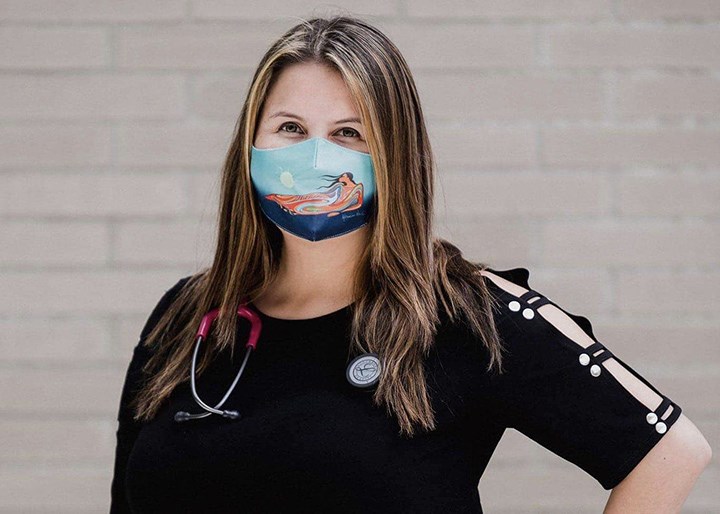When Wyonna Cahoose was in the Kamloops Royal Inland hospital giving birth to her son eight years ago, she was inspired by the nurses who helped her — and was inspired to become a nurse herself.
Cahoose, who is Tsilhqotʼin and Carrier Dakelh (Ulkatcho Nation at Anahim Lake), was 18 years-old when she met the nurses who would shape her future career path.
“This nurse in maternity was very confident. When I was starting to be in pain, she took my hand and looked in my eyes. I made eye contact,” she remembers.
“I didn’t really connect with anyone, I would say I was very cautious. She just held my hands and said ‘We’re going to have a baby, you’re going to get through this.’”
After her son was delivered, a student nurse came into the hospital and Cahoose began talking to her about her career.
Cahoose spent the next two years upgrading her education and then was accepted into the nursing program at Thompson Rivers University (TRU), located in Secwepemc territory of Kamloops.
TRU accepts only 80 nursing students a year so it can be a challenge, Cahoose says, but she credits her son Darious as a driving motivation.
Darious is now eight years-old, and Cahoose says she starts her day by waking him up and playing a game of which clothes are weather appropriate. She balances parenting with a busy program schedule involving coursework and 12 hour clinical practice shifts at the hospital.
As Cahoose reflects now, she says it wasn’t easy to get here. She had always been interested in nursing, but she didn’t think her academics would be strong enough, she says.
Cahoose was moved around a lot to different boarding situations during childhood, she says, which made focusing on her grades difficult. In high school alone, she says she was moved around about a dozen times.
“Lots of different homes all the time,” she says. “It was like foster care. I was always with people, but people would never really want me.”
Cahoose is originally from Nimpo Lake and had to leave home again to pursue her education in nursing. Her university is about an eight-hour drive from home.
“When I think about everything that it takes just to start on this kind of journey — it takes a lot of dedication to be in a world that's not really your world from the reserve,” she shares.
During her first year in the nursing program, she says, she had to take about six months away to heal from a traumatic situation.
She wasn’t sure if she could return to the nursing program, but attended a graduation ceremony to support her fellow classmates. Cahoose says the dean of nursing at the time, Donna Murnaghan, and instructor Barbara Buckley approached her afterwards.
“They pulled me aside, and asked if I was coming back in the fall,” she says.
“Barbara Buckley said: ‘You’re not going to quit. Build a strong foundation for yourself, reapply and come back.’”
She considered their encouragement, and challenged herself.
“[I thought] ‘What happens if I really try and really push myself?’ So I did,” Cahoose says. “And I've been excelling at clinical ever since. And I'm just about to end my third year, after I finish my practicum.”
Cahoose adjusted, filtered out hurdles of prejudice when they appeared, and strengthened herself through her personal support network.
There are not many Indigenous students in her program, she says, but she has two peers she’s close to, which has helped.
The need for cultural safety and Indigenous history in the curriculum was clear, says Cahoose.
“In my first year, it was kind of a shock. When I was in class, and they talked about Indigenous people, I didn’t like it. I went red in the face, I was uncomfortable,” she says.
“When they’d be talking about residential school, people would say, ‘I went to Christian school — I never heard about residential school.’”
“It was just a shock to hear from so many first year nursing students who didn't know about residential schools, didn’t know about hardships Indigenous people face, and all the stigma around it.”
Mandatory Indigenous cultural competency is now interwoven throughout the nursing curriculum at TRU.
“Learning activities around promoting Indigenous Peoples’ health are threaded throughout the BScN curriculum starting in Year 1,” says TRU program website.
For example, these themes would be interwoven into first year coursework including units on self awareness, understanding determinants of health, and standards of ethical nursing practice.
“I felt really happy to know the curriculum has changed. Nurses should at least know- because we work with some of the more vulnerable populations,” Cahoose says.
She says her wish is for nurses, and society at large, is “to be more knowledgeable, to have an idea of who we are, how we struggle and how we overcome all our obstacles.”



